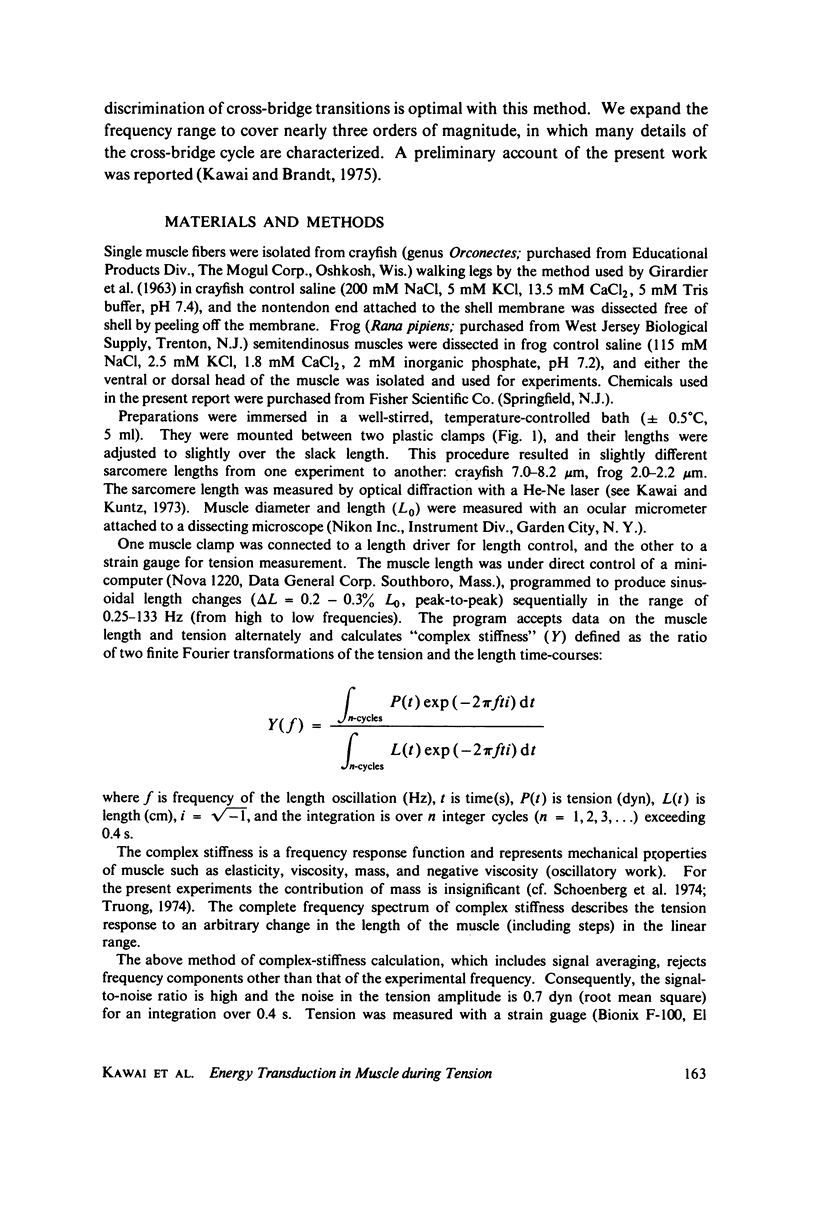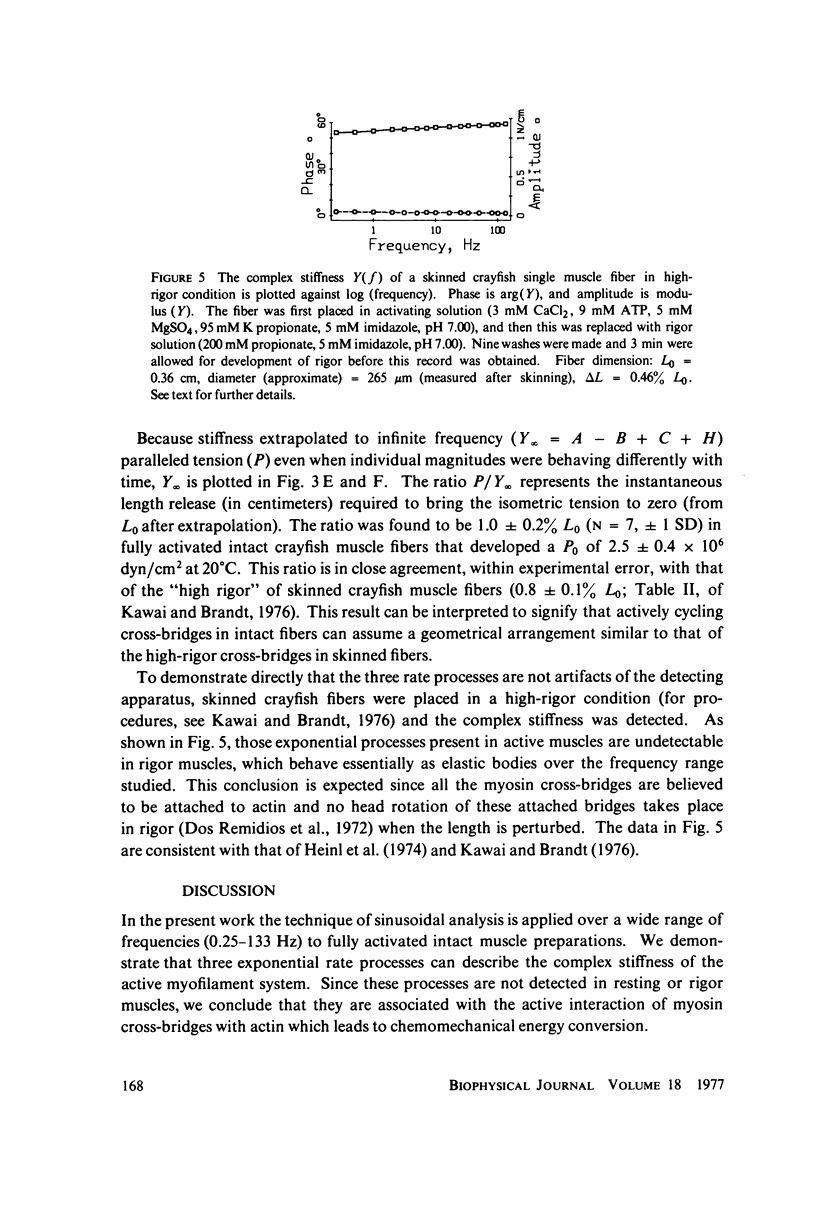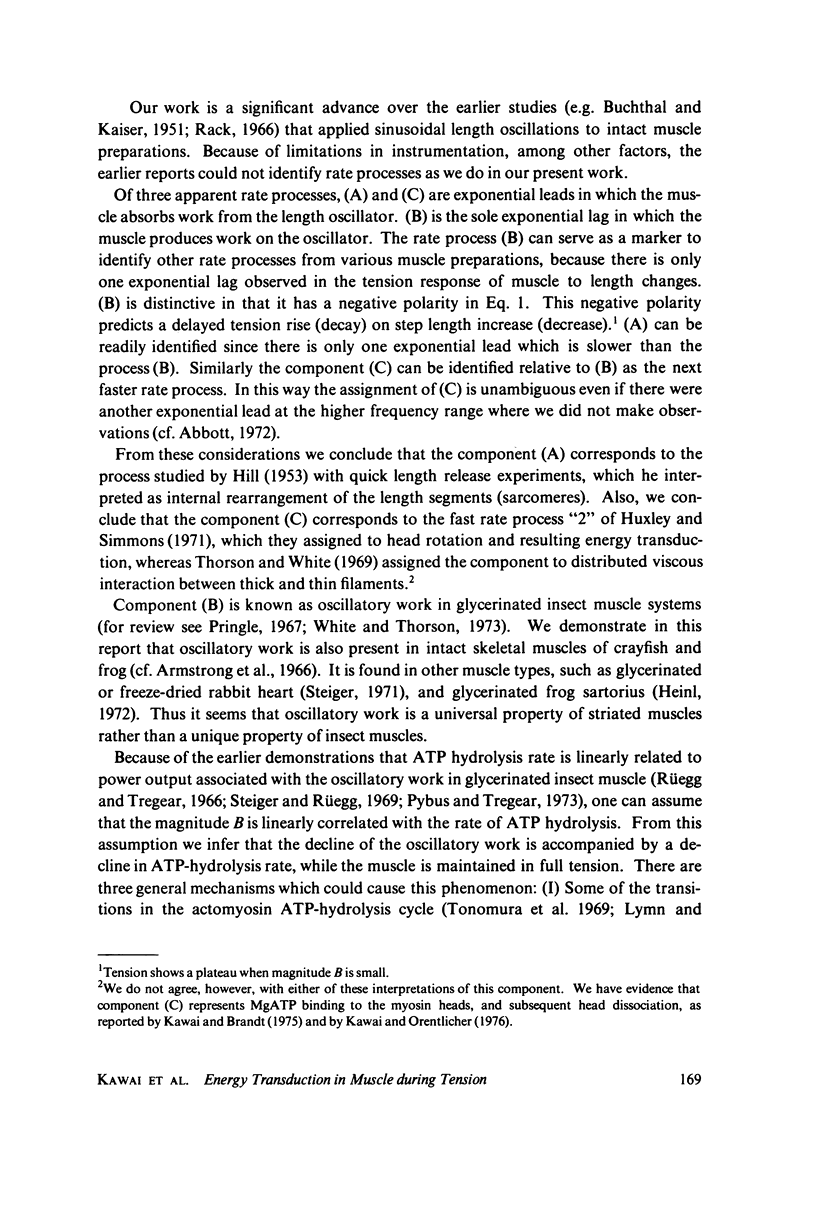Abstract
In intact single crayfish muscle fibers and frog semitendinosus muscles we have studied the tension response to sinusoidal length changes in the frequency range of 0.25-133 Hz. By this method we have resolved three processes in the interaction of myosin cross-bridges with actin in fully activated preparations. They are (A) a low-frequency phase advance, (B) a middle-frequency delay, and (C) a high-frequency advance. These processes can be used as probes to study the chemomechanical coupling of contractility. Process (B) represents net power output from the muscle preparation (oscillatory work). With maximal K or caffeine activation of crayfish muscle at 20 degrees C, it decreases to zero in the initial 45 s of maintained tension. Similar results were obtained with frog semitendinosus whole muscles. We interpret this decrease of (B) with time as a gradual decrease in actomyosin ATP-hydrolysis rate.
Full text
PDF











Selected References
These references are in PubMed. This may not be the complete list of references from this article.
- Abbott R. H. Comments on the mechanism of force generation in striated muscles. Nat New Biol. 1972 Oct 11;239(93):183–187. doi: 10.1038/newbio239183a0. [DOI] [PubMed] [Google Scholar]
- Brandt P. W., Orentlicher M. Muscle energetics and the Fenn effect. Biophys J. 1972 May;12(5):512–527. doi: 10.1016/S0006-3495(72)86100-9. [DOI] [PMC free article] [PubMed] [Google Scholar]
- Chiarandini D. J., Reuben J. P., Girardier L., Katz G. M., Grundfest H. Effects of caffeine on crayfish muscle fibers. II. Refractoriness and factors influencing recovery (repriming) of contractile responses. J Gen Physiol. 1970 May;55(5):665–687. doi: 10.1085/jgp.55.5.665. [DOI] [PMC free article] [PubMed] [Google Scholar]
- Dickinson V. A., Woledge R. C. Proceedings: Reduction of shortening heat during a series of tetanic contractions in frog sartorius muscle. J Physiol. 1974 Oct;242(2):98P–99P. [PMC free article] [PubMed] [Google Scholar]
- Dos Remedios C. G., Millikan R. G., Morales M. F. Polarization of tryptophan fluorescence from single striated muscle fibers. A molecular probe of contractile state. J Gen Physiol. 1972 Jan;59(1):103–120. doi: 10.1085/jgp.59.1.103. [DOI] [PMC free article] [PubMed] [Google Scholar]
- Fenn W. O. A quantitative comparison between the energy liberated and the work performed by the isolated sartorius muscle of the frog. J Physiol. 1923 Dec 28;58(2-3):175–203. doi: 10.1113/jphysiol.1923.sp002115. [DOI] [PMC free article] [PubMed] [Google Scholar]
- GIRARDIER L., REUBEN J. P., BRANDT P. W., GRUNDFEST H. EVIDENCE FOR ANION-PERMSELECTIVE MEMBRANE IN CRAYFISH MUSCLE FIBERS AND ITS POSSIBLE ROLE IN EXCITATION-CONTRACTION COUPLING. J Gen Physiol. 1963 Sep;47:189–214. doi: 10.1085/jgp.47.1.189. [DOI] [PMC free article] [PubMed] [Google Scholar]
- Gilbert C., Kretzschmar K. M., Wilkie D. R., Woledge R. C. Chemical change and energy output during muscular contraction. J Physiol. 1971 Oct;218(1):163–193. doi: 10.1113/jphysiol.1971.sp009609. [DOI] [PMC free article] [PubMed] [Google Scholar]
- HILL A. V. The mechanics of active muscle. Proc R Soc Lond B Biol Sci. 1953 Mar 11;141(902):104–117. doi: 10.1098/rspb.1953.0027. [DOI] [PubMed] [Google Scholar]
- Heinl P., Kuhn H. J., Rüegg J. C. Tension responses to quick length changes of glycerinated skeletal muscle fibres from the frog and tortoise. J Physiol. 1974 Mar;237(2):243–258. doi: 10.1113/jphysiol.1974.sp010480. [DOI] [PMC free article] [PubMed] [Google Scholar]
- Heinl P. Mechanische aktivierung und Deaktivierung der isolierten contractilen Struktur des froschsartorius durch rechteckförmige und sinusförmige Längenänderungen. Pflugers Arch. 1972;333(3):213–226. doi: 10.1007/BF00592684. [DOI] [PubMed] [Google Scholar]
- Huxley A. F., Simmons R. M. Proposed mechanism of force generation in striated muscle. Nature. 1971 Oct 22;233(5321):533–538. doi: 10.1038/233533a0. [DOI] [PubMed] [Google Scholar]
- Kawai M., Brandt P. W. Two rigor states in skinned crayfish single muscle fibers. J Gen Physiol. 1976 Sep;68(3):267–280. doi: 10.1085/jgp.68.3.267. [DOI] [PMC free article] [PubMed] [Google Scholar]
- Kawai M., Kuntz I. D. Optical diffraction studies of muscle fibers. Biophys J. 1973 Sep;13(9):857–876. doi: 10.1016/S0006-3495(73)86031-X. [DOI] [PMC free article] [PubMed] [Google Scholar]
- Lymn R. W., Taylor E. W. Mechanism of adenosine triphosphate hydrolysis by actomyosin. Biochemistry. 1971 Dec 7;10(25):4617–4624. doi: 10.1021/bi00801a004. [DOI] [PubMed] [Google Scholar]
- Machin K. E. Feedback theory and its application to biological systems. Symp Soc Exp Biol. 1964;18:421–445. [PubMed] [Google Scholar]
- Marston S. B., Tregear R. T. Evidence for a complex between myosin and ADP in relaxed muscle fibres. Nat New Biol. 1972 Jan 5;235(53):23–24. doi: 10.1038/newbio235023a0. [DOI] [PubMed] [Google Scholar]
- Marston S. The nucleotide complexes of myosin in glycerol-extracted muscle fibres. Biochim Biophys Acta. 1973 May 30;305(2):397–412. doi: 10.1016/0005-2728(73)90186-2. [DOI] [PubMed] [Google Scholar]
- Pringle J. W. The contractile mechanism of insect fibrillar muscle. Prog Biophys Mol Biol. 1967;17:1–60. doi: 10.1016/0079-6107(67)90003-x. [DOI] [PubMed] [Google Scholar]
- Rack P. M. The behaviour of a mammalian muscle during sinusoidal stretching. J Physiol. 1966 Mar;183(1):1–14. doi: 10.1113/jphysiol.1966.sp007848. [DOI] [PMC free article] [PubMed] [Google Scholar]
- Reuben J. P., Brandt P. W., Berman M., Grundfest H. Regulation of tension in the skinned crayfish muscle fiber. I. Contraction and relaxation in the absence of Ca (pCa is greater than 9). J Gen Physiol. 1971 Apr;57(4):385–407. doi: 10.1085/jgp.57.4.385. [DOI] [PMC free article] [PubMed] [Google Scholar]
- Reuben J. P., Brandt P. W., Garcia H., Grundfest H. Excitation-contraction coupling in crayfish. Am Zool. 1967 Aug;7(3):623–645. doi: 10.1093/icb/7.3.623. [DOI] [PubMed] [Google Scholar]
- Rüegg J. C., Tregear R. T. Mechanical factors affecting the ATPase activity of glycerol-extracted insect fibrillar flight muscle. Proc R Soc Lond B Biol Sci. 1966 Oct 11;165(1001):497–512. doi: 10.1098/rspb.1966.0080. [DOI] [PubMed] [Google Scholar]
- Schoenberg M., Wells J. B., Podolsky R. J. Muscle compliance and the longitudinal transmission of mechanical impulses. J Gen Physiol. 1974 Dec;64(6):623–642. doi: 10.1085/jgp.64.6.623. [DOI] [PMC free article] [PubMed] [Google Scholar]
- Steiger G. J., Rüegg J. C. Energetics and "efficiency" in the isolated contractile machinery of an insect fibrillar muscle at various frequencies of oscillation. Pflugers Arch. 1969;307(1):1–21. doi: 10.1007/BF00589455. [DOI] [PubMed] [Google Scholar]
- Steiger G. J. Stretch activation and myogenic oscillation of isolated contractile structures of heart muscle. Pflugers Arch. 1971;330(4):347–361. doi: 10.1007/BF00588586. [DOI] [PubMed] [Google Scholar]
- Thorson J., White D. C. Distributed representations for actin-myosin interaction in the oscillatory contraction of muscle. Biophys J. 1969 Mar;9(3):360–390. doi: 10.1016/S0006-3495(69)86392-7. [DOI] [PMC free article] [PubMed] [Google Scholar]
- Tonomura Y., Nakamura H., Kinoshita N., Onishi H., Shigekawa M. The pre-steady state of the myosin-adenosine triphosphate system. X. The reaction mechanism of the myosin-ATP system and a molecular mechanism of muscle contraction. J Biochem. 1969 Nov;66(5):599–618. [PubMed] [Google Scholar]
- Truong X. T. Viscoelastic wave propagation and rheologic properties of skeletal muscle. Am J Physiol. 1974 Feb;226(2):256–264. doi: 10.1152/ajplegacy.1974.226.2.256. [DOI] [PubMed] [Google Scholar]


